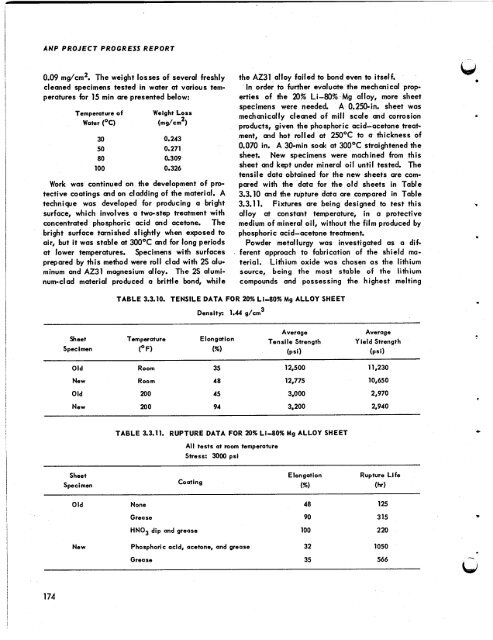ORNL-2106 - the Molten Salt Energy Technologies Web Site
ORNL-2106 - the Molten Salt Energy Technologies Web Site
ORNL-2106 - the Molten Salt Energy Technologies Web Site
You also want an ePaper? Increase the reach of your titles
YUMPU automatically turns print PDFs into web optimized ePapers that Google loves.
AUP PROJECT PROGRESS REPORT<br />
0.09 mg/cm2. The weight losses of several freshly<br />
cleaned specimens tested in water at various tem-<br />
peratures for 15 min are presented below:<br />
Temperature of Weight Loss<br />
Water (OC) (mg/cm2)<br />
30<br />
50<br />
80<br />
100<br />
0.243<br />
0.271<br />
0.309<br />
0.326<br />
Work was continued on <strong>the</strong> development of pro-<br />
tective coatings and on cladding of <strong>the</strong> material. A<br />
techniqe was developed for producing a bright<br />
surface, which involves a two-step treatment with<br />
concentrated phosphoric acid and acetone. The<br />
bright surface tarnished slightly when exposed to<br />
air, but it was stable at 3OOOC md for long periods<br />
at lower temperatures. Specimens with surfaces<br />
prepared by this method were roll clad with 2s alu-<br />
minum and AZ31 magnesium alloy. The 25 alumi-<br />
num-clad material produced a brittle bond, while<br />
1 74<br />
<strong>the</strong> AZ31 alloy failed to bond even to itself.<br />
In order to fur<strong>the</strong>r evaluate <strong>the</strong> mechanical prop-<br />
erties of <strong>the</strong> 20% Li-80% Mg alloy, more sheet<br />
specimens were needed. A 0.250-in. sheet was<br />
mechanically clecmed of mill scale and corrosion<br />
products, given <strong>the</strong> phosphoric acid-acetone treat-<br />
ment, and hot rolled at 25OOC to a thickness of<br />
0.070 in. A 30-min soak at 3OOOC straightened <strong>the</strong><br />
sheet. New specimens were machined from this<br />
sheet and kept under mineral oil until tested. The<br />
tensile data obtained for <strong>the</strong> new sheets are com-<br />
pared with <strong>the</strong> data for <strong>the</strong> old sheets in Table<br />
3.3.10 and <strong>the</strong> rupture data are compared in Table<br />
3.3.11, Fixtures are being designed to test this<br />
alloy at constant temperature, in a protective<br />
medium of mineral oil, without <strong>the</strong> film produced by<br />
phosphoric acid-acetone treatment.<br />
Powder metallurgy was investigated as a dif-<br />
ferent approach to fabrication of <strong>the</strong> shield ma-<br />
terial. Lithium oxide was chosen as <strong>the</strong> lithium<br />
source, being <strong>the</strong> most stable of <strong>the</strong> lithium<br />
compounds and possessing <strong>the</strong> highest melting<br />
TABLE 3.3.10. TENSILE DATA FOR 20% Li-80% Mg ALLOY SHEET<br />
Density: 1.44 g/cm 3<br />
Average Average<br />
Sheet Temperature Elongation Tensile Strength Yield Strength<br />
Specimen<br />
(Or-) (%I (psi) (psi)<br />
Old Room 35 12,500 11.230<br />
New Room 48 12,775 10,650<br />
0 Id 200 45 3.000 2,970<br />
New 200 94 3.200 2.940<br />
TABLE 3.3.11. RUPTURE DATA FOR 20% Li-SOX Mg ALLOY SHEET<br />
All tests at mom temperature<br />
Stress: 3000 psi<br />
Sheet Elongation Rupture Life<br />
Specimen<br />
Coating<br />
(%I (hr)<br />
Old None 48 125<br />
Grease 90 315<br />
HN03 dip and grease 100 220<br />
New Phosphoric acid, acetone, and grease 32 1050<br />
Grease 35 566<br />
t$<br />
W



![Review of Molten Salt Reactor Physics Calculations [Disc 2]](https://img.yumpu.com/21979492/1/190x247/review-of-molten-salt-reactor-physics-calculations-disc-2.jpg?quality=85)













